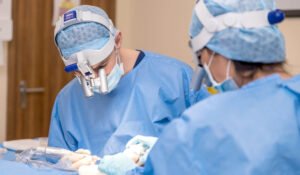In the realm of hair restoration, a groundbreaking technique has emerged to address the concerns of individuals facing alopecia—DHI technology for hair transplant. Direct Implantation, commonly known as DHI, is an advanced approach that has revolutionized the field of transplants. We will provide an in-depth understanding of DHI and how it plays a pivotal role in restoring a natural and aesthetically pleasing hairline.
Understanding DHI Technology Methodology and Precision
DHI is distinguished by its meticulous methodology. During the procedure, trained professionals extract individual follicles from the donor area using specialized tools. These follicles are then directly implanted into the recipient area, ensuring precise placement and mimicking the natural growth pattern of hair. The controlled implantation angle and depth contribute to a seamlessly natural appearance.
Innovative Implantation Pen
Central to DHI’s success is the unique implantation pen, which enables precise control over the depth, direction, and angle at which follicles are implanted. This innovation enhances the overall aesthetic outcome, creating a hairline that aligns with the patient’s facial features and desired appearance.
The Unique Advantages of DHI
1. Aesthetically Pleasing Results
The artistry involved in DHI technology for hair transplant ensures that the restored hairline is in harmony with the individual’s face, age, and gender. The ability to precisely control the implantation process results in a natural-looking hairline that blends seamlessly with existing hair.
2. Minimized Transection Rates
Transection refers to the inadvertent cutting of follicles during extraction or implantation. DHI technology for hair transplant significantly reduces transection rates, preserving the integrity of follicles and enhancing the success of the transplant.
3. Reduced Healing Time
DHI’s minimally invasive approach leads to faster healing times. Patients typically experience minimal discomfort and can resume their daily activities sooner than with traditional transplant methods.
4. Higher Graft Survival Rate
DHI technology for hair transplant ensures that each graft is handled with care and precision during the transplant. This translates to a higher graft survival rate and improved chances of successful hair growth after the procedure.
5. No Visible Scarring
Unlike traditional strip harvesting methods, DHI does not leave a linear scar on the donor area. The microsurgical extraction process ensures minimal scarring, allowing patients to wear their hair short without worrying about visible scars.
6. Customizable Hair Density
DHI offers the flexibility to customize the hair density according to the patient’s preferences and specific needs. Surgeons can meticulously control the spacing and distribution of the implanted follicles, resulting in a natural and aesthetically pleasing hair density.
7. Long-term Natural Results
With DHI, the transplanted hair continues to grow naturally over time. The implanted follicles adapt to the natural growth cycle of the patient, delivering lasting, authentic results that blend seamlessly with the rest of the hair.
Navigating DHI Aftercare: Tips for Optimal
Healing and Growth
After undergoing the DHI procedure, following proper aftercare is crucial for optimal healing and successful growth.
1. Delicate Cleaning
Gently clean the treated area as per the surgeon’s instructions to prevent dislodging the implanted follicles. Use mild shampoos and avoid vigorous rubbing.
2. Protection from Sun Exposure
Shield your scalp from direct sunlight by wearing a hat or using a recommended sunscreen. Sun exposure can potentially harm the delicate, healing scalp and newly implanted follicles.
3. Strict Adherence to Medication Regimen
Adhere to any prescribed medications diligently, as they are crucial for aiding healing and promoting healthy hair growth after the DHI procedure.
4. Avoid Strenuous Activities and Sweating
For the first week after the procedure, refrain from strenuous activities that may induce sweating or increased blood flow to the scalp. Sweating can irritate the treated area and potentially affect the implanted follicles.
5. Appropriate Sleeping Position
During the initial healing phase, it’s advisable to sleep with your head elevated using an extra pillow. This position helps minimize swelling and accelerates the healing process.
6. Limit Alcohol Consumption and Smoking
Alcohol consumption and smoking can hinder the healing process and impact hair growth. It’s best to avoid or limit these activities during the initial recovery period.
7. Maintain a Healthy Diet
A well-balanced diet rich in essential vitamins and minerals promotes overall healing and supports healthy growth. Include a variety of fruits, vegetables, lean proteins, and adequate hydration in your daily diet.
8. Regular Follow-ups with Your Surgeon
Schedule and attend follow-up appointments with your surgeon as recommended. These check-ups allow the surgeon to monitor your progress, ensure proper healing, and address any concerns promptly.
FAQs
Q1: Is DHI suitable for both men and women?
Yes, DHI technology is effective for both men and women experiencing alopecia. It offers a tailored approach to restore a natural hairline and density, regardless of gender.
Q2: Are the results of DHI permanent?
Yes, the results of DHI are permanent. The transplanted hair follicles are taken from the patient’s own donor area, making them genetically resistant to hair loss.
Q3: How long does a DHI procedure typically take?
The duration of a DHI procedure can vary based on the extent of the restoration needed. On average, a DHI session may last anywhere from 4 to 8 hours.
Q4: Can I undergo more than one DHI procedure if needed? Yes, it is possible to undergo multiple DHI procedures if further hair restoration or enhancements are desired. However, the decision to undergo additional procedures should be discussed with your surgeon, considering factors such as the availability of sufficient donor hair, overall health, and individual hair loss progression.
Q5: Will the transplanted hair require any special maintenance in the long run?
No, the transplanted hair does not require any special maintenance in the long run. Once the transplanted hair grows and matures, you can maintain it just like your natural hair. Regular washing, conditioning, and occasional trims are typically sufficient to keep the transplanted hair looking healthy and natural.
Q6: Can DHI be used to restore hair in other areas of the body besides the scalp?
Yes, DHI can be used to restore hair in other areas of the body, such as the eyebrows, beard, chest, or pubic area. The same meticulous DHI technology for hair transplant can be adapted for these areas to achieve natural-looking results.
Conclusion
DHI technology for hair transplant represents a significant leap forward in the field of restoration. Its ability to restore a natural hairline with precision, minimal invasiveness, and reduced healing times sets it apart. By following appropriate aftercare measures, you can optimize the results of your DHI procedure. In conclusion, if you’re considering a transplant, exploring DHI as an option could be a significant step towards regaining your confidence and achieving a natural-looking hairline.

